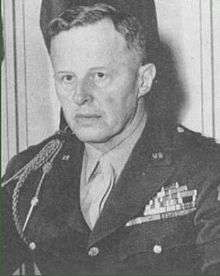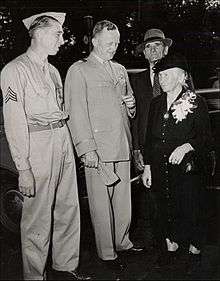John W. Leonard
Lieutenant General John William Leonard (January 25, 1890 – October 26, 1974) was a highly decorated senior United States Army officer[1] who served during World War I, World War II and Cold War.
John William Leonard | |
|---|---|
 | |
| Born | January 25, 1890 Toledo, Ohio |
| Died | October 26, 1974 (aged 84) |
| Allegiance | |
| Service/ | |
| Years of service | 1915–1952 |
| Rank | |
| Unit | |
| Commands held | 9th Armored Division 20th Armored Division 2nd Armored Division V Corps XVIII Airborne Corps |
| Battles/wars | World War I World War II Cold War |
| Awards | Distinguished Service Cross Distinguished Service Medal |
Early years and World War I
John William Leonard was born on January 25, 1890 in Toledo, Ohio as a son of Dennis and Anastasia Leonard. He graduated from the United States Military Academy in 1915, as part of "the class the stars fell on", a famous class of West Point, from which Dwight D. Eisenhower or Omar N. Bradley graduated. Many years later Dwight D. Eisenhower would introduce John to his future wife.
His first war service was at Mexico – United States border. Then, in May 1918, he was sent as a member of the 6th Infantry Regiment of the 5th Infantry Division within American Expeditionary Forces to the France.
Reaching the rank of major, Leonard commanded a battalion of the 6th Infantry Regiment during Battle of Saint-Mihiel and Meuse-Argonne Offensive. For his bravery on the battlefield near the village of Romagne-sous-Montfaucon, Major Leonard was promoted to the rank of lieutenant colonel and decorated with the Distinguished Service Cross, Purple Heart French Legion of Honor, Croix de Guerre with Palm and French Fourragère.[2]
Distinguished Service Cross citation
His official Distinguished Service Cross citation reads:
- General Orders: War Department, General Orders No. 37 (1919)
- Action Date: October 14, 1918
- Name: John William Leonard
- Service: Army
- Rank: Lieutenant Colonel
- Regiment: 6th Infantry Regiment
- Division: 5th Division, American Expeditionary Forces
- Citation: The President of the United States of America, authorized by Act of Congress, July 9, 1918, takes pleasure in presenting the Distinguished Service Cross to Lieutenant Colonel (Infantry), [then Major] John William Leonard (ASN: 0-3840), United States Army, for extraordinary heroism in action while serving with 6th Infantry Regiment, 5th Division, A.E.F., near Romagne, France, 14 October 1918. Lieutenant Colonel Leonard personally led the assaulting wave in an attack under severe shell and machine-gun fire from the front arid flanks. Upon reaching the objective he directed the organization of the position, and by his example of fearlessness rallied his men and kept his line intact.[3]
After the war, Leonard stayed in Europe for occupation duties until October, 1921. Then he served on various posts, including a posting to Tientsin China 1933–1936. In 1936, Leonard was appointed an Instructor for Maryland National Guard and stayed in this capacity until 1940.[4] Then he spent some time on the staff of the 2nd Infantry Division under command of Major General James Lawton Collins.
Second World War
During the year 1941, Leonard was promoted to the capacity of the commanding officer of the 6th Armored Infantry Regiment, which was now a part of the 1st Armored Division under the command of Major General Bruce Magruder. During this time, 6th Armored Infantry Regiment was stationed with whole 1st Armored Division at Fort Knox in Kentucky. Leonard was promoted to the rank of brigadier general on June 20, 1942.
During the summer of 1942 Brigadier General Leonard was put in command of the newly activated 9th Armored Division at Fort Riley, Kansas. In this capacity, Leonard replaced Major General Geoffrey Keyes at the end of September, 1942.[5] On October 27, 1942, Leonard got his second star, when he was promoted to the rank of major general.
Two years later, in September 1944, 9th Armored Division was transferred to the United Kingdom, from where it was immediately ordered to Normandy.
Leonard continued as its commander until the end of the war, when he became commander of the 20th Armored Division. During the period between the wars, he served as commandant of the Armor School from 1946, and as military attaché in the United Kingdom from 1948. In 1950 he was promoted to lieutenant general and commanded both the V Corps and the XVIII Airborne Corps when it was reestablished on 31 May 1951. He retired from the army in January 1952.
Decorations
Lieutenant General Leonard´s ribbon bar:
| 1st Row | Distinguished Service Cross | Army Distinguished Service Medal | ||||||||||||||
|---|---|---|---|---|---|---|---|---|---|---|---|---|---|---|---|---|
| 2nd Row | Silver Star | Legion of Merit w/ Oak Leaf Cluster |
Bronze Star Medal w/ Oak Leaf Cluster |
Purple Heart | ||||||||||||
| 3rd Row | Mexican Border Service Medal | World War I Victory Medal w/ three battle clasps |
Army of Occupation of Germany Medal | American Defense Service Medal | ||||||||||||
| 4th Row | American Campaign Medal | European-African-Middle Eastern Campaign Medal w/ four service stars | World War II Victory Medal | Army of Occupation Medal | ||||||||||||
| 5th Row | National Defense Service Medal | Officer of the Legion of Honour | French Croix de guerre 1914–1918 w/ palm | Croix de guerre (Belgium) w/ palm | ||||||||||||
Gallery
 John W. Leonard as a West Point cadet.
John W. Leonard as a West Point cadet. John W. Leonard as a major during World War I after he received his Distinguished Service Cross.
John W. Leonard as a major during World War I after he received his Distinguished Service Cross. Major General John W. Leonard with his mother Anastasia during his visit in the US. His mother died in 1948.
Major General John W. Leonard with his mother Anastasia during his visit in the US. His mother died in 1948. Sgt. Alexander A. Drabik receiving a Distinguished Service Cross for his actions during the Battle of Remagen from the MG John W. Leonard, Commanding officer of the 9th Armored Division.
Sgt. Alexander A. Drabik receiving a Distinguished Service Cross for his actions during the Battle of Remagen from the MG John W. Leonard, Commanding officer of the 9th Armored Division. Major General John W. Leonard, Sgt. Alexander A. Drabik and his Parents in Toledo Zoo on August 18, 1945.
Major General John W. Leonard, Sgt. Alexander A. Drabik and his Parents in Toledo Zoo on August 18, 1945.
References
- "John William Leonard, Lieutenant General, United States Army". Arlingtoncemetery.net. Retrieved 29 November 2014.
- Jeffrey Smith. "Catholic Architecture and History of Toledo, Ohio". Catholictoledo.blogspot.cz. Retrieved 29 November 2014.
- "John William Leonard". Militarytimes.com. Retrieved 29 November 2014.
- "Biography of Major-General John William Leonard (1890 – 1974), USA". Generals.dk. Retrieved 29 November 2014.
- "Officers of the US Army 1939-1945 -- K". Unithistories.com. Retrieved 29 November 2014.